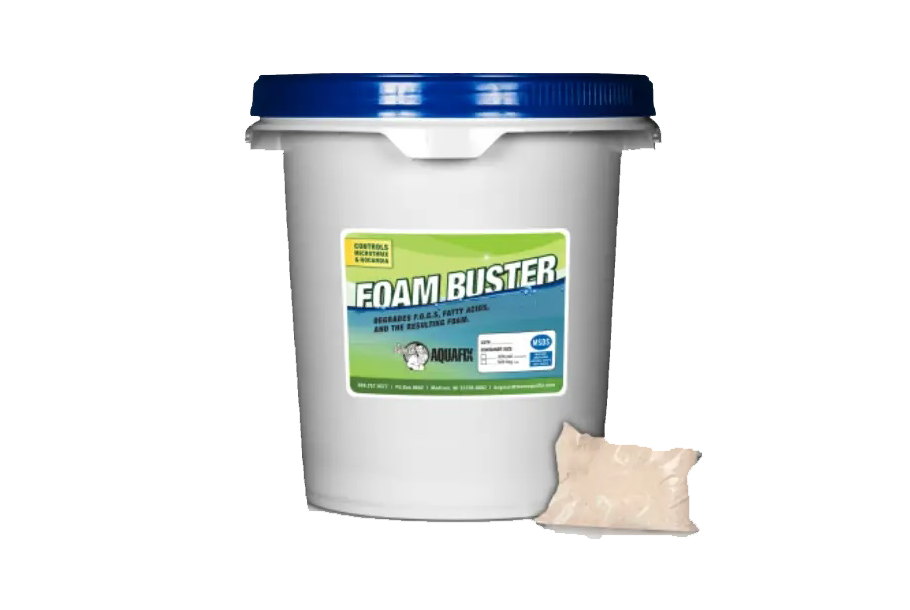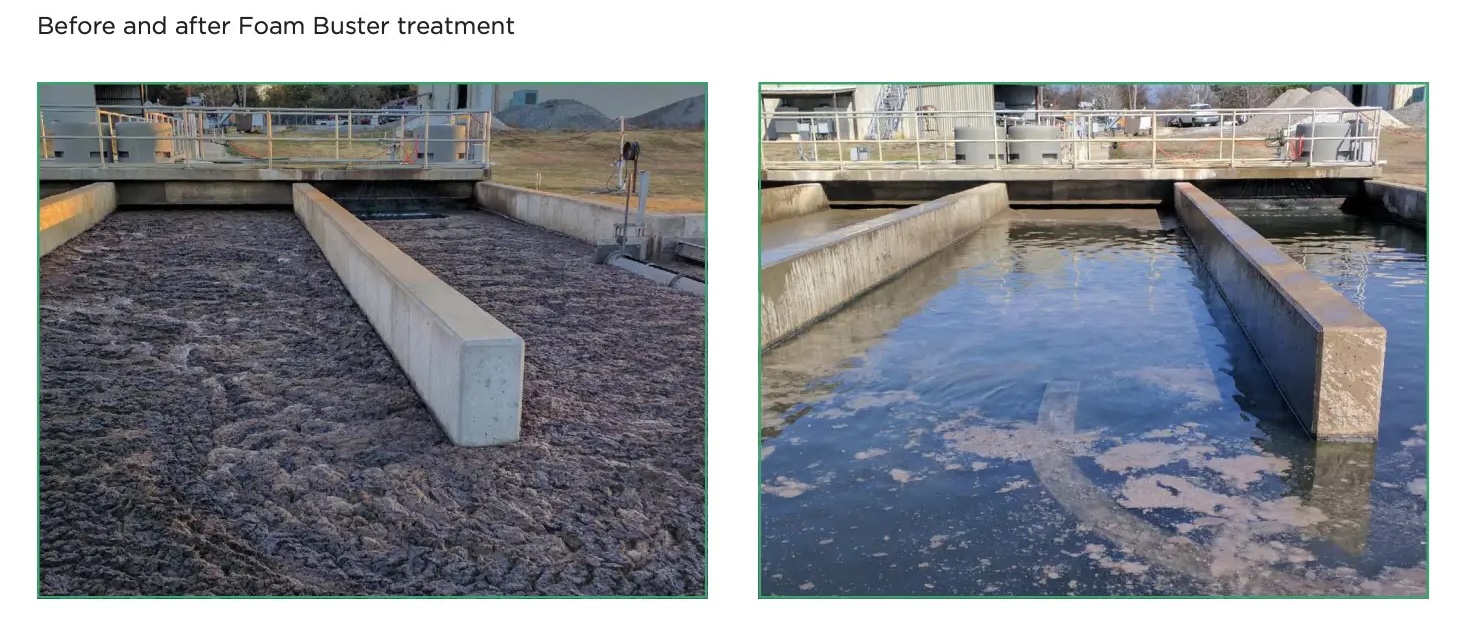When it comes to wastewater treatment, foam control is a common challenge. In some cases, when foam builds up in aeration tanks or in digesters, it can create health and safety issues for workers as well as damage equipment and disrupt operations.
To help with this, many wastewater treatment plants rely on chemical defoamers to keep the foam under control, but these can be costly and create environmental concerns.
Foam Buster takes a different approach. It uses a carefully selected blend of naturally occurring bacteria and enzymes, which work by targeting the causes of foam at the source. The result is a safe and sustainable solution that’s affordable and highly effective for wastewater treatment plants.
What Causes Foam in Wastewater Treatment Plants?
Foam in wastewater treatment plants is a common scenario that results when conditions in the treatment process favour certain compounds or bacteria. Common causes include:
- Filamentous bacteria such as Nocardia and Microthrix parvicella
- Surfactants from industrial wastewater
- High levels of fats, oils, and grease (FOG)
- Over-aeration or surges in biological activity
If foam is not managed, it can lead to:
- Damage to plant equipment
- Reduced oxygen transfer
- Sludge carryover
- Strong odours
- Safety risks for staff working near tanks or digesters
What Is Foam Buster?
After decades of testing wastewater treatments, we settled on Foam Buster as our go-to product for dealing with foam. We stand by Foam Buster because of its eco-friendly features and exceptional ability to get the job done, reducing foam. This biological foam control product works by using naturally-occurring microbes and enzymes to tackle the root causes of foaming, unlike other products that just mask the problem.
Foam Buster’s key features are:
- Fully biodegradable and eco-friendly
- Targets foam-causing bacteria and organic compounds
- Works in both aerobic and anaerobic environments
- Safe for operators and downstream processes
How Does Foam Buster Work?
Like we mentioned before, Foam Buster introduces beneficial microbes directly into the system instead of masking it.
These microbes and enzymes work in three important ways:
1. Outcompetes Filamentous Bacteria
Foam Buster contains microbes that colonise the sludge and displace organisms like Nocardia. As their numbers fall, so does the foam they create.
2. Breaks Down Fats, Oils, and Grease (FOG)
Excess FOG is one of the most common drivers of foam. The enzymes and bacteria in Foam Buster digest these compounds, reducing the conditions that allow foam to form.
3. Stabilises Biological Activity
Foam can also appear when microbial activity spikes. Foam Buster helps balance the microbial community, preventing sudden surges and keeping the treatment process stable.
What Are the Benefits of Using Foam Buster?
If you want to tackle your foaming issue altogether, Foam Buster is an excellent option.
To help give you a better idea of the benefits of using the product (as opposed to other ones on the market), we’ve created a table that clearly states what sets it apart:
|
Benefit |
What It Means for Your Plant |
|
Environmentally friendly |
Biodegrades completely, leaves no harmful residues, and has no negative impact on effluent |
|
Cost-effective |
Cuts down on chemical use and reduces foam-related maintenance, labour, and downtime costs |
|
Improves efficiency |
Supports better sludge settling, oxygen transfer, and nutrient removal |
| Safe for operators |
Non-toxic, non-corrosive, and safe to handle, lowering risks for plant staff |
Application Areas
Foam Buster is suitable for a wide range of wastewater treatment systems, including:
- Municipal treatment plants
- Industrial wastewater facilities
- Aeration tanks
- Anaerobic digesters
- Sequencing batch reactors (SBRs)
- Moving bed biofilm reactors (MBBRs)
Real-World Results
Plants using Foam Buster have seen clear improvements, such as:
- Up to 90% reduction in foam within weeks
- More stable sludge and improved settling
- Less odour and safer conditions for staff
- Reduced long-term operational costs
Case Study: Chicago Wastewater Plant
The Challenge
A municipal wastewater facility on Chicago’s south side, operating at approximately 4.16 million litres per day, was battling persistent foam caused by Nocardia filaments. The entire surface of the aeration basins was covered in foam, and the problem extended into the clarifier walls themselves. In addition to foaming, the plant was struggling with weekend ammonia spikes—levels surged to 60 ppm from a baseline of 15–20 ppm.
The Solution
To address both the foam and chemical instability, the plant operators introduced Foam Buster in combination with Qwik-Zyme L. This dual treatment was aimed at accelerating the breakdown of surfactants, grease, and long-chain fatty acids—key nutrients feeding the Nocardia population.
The Results
- Within 30 days, foam levels were reduced by approximately 75%.
- Post-treatment, the facility transitioned to a maintenance dose to sustain clear conditions.
- The breakdown of excess grease and fatty acids improved the system’s nitrogen consumption, helping to tame ammonia spikes.
- Interestingly, it was later discovered that upstream an illegal methamphetamine lab had been causing the recurring ammonia surges. Once shut down, the ammonia influx ceased—confirming that the foam issue had been compounded by external chemical stressors.
How to Apply Foam Buster
Foam Buster is simple to use and can be adjusted to the specific conditions of your plant.
Here’s how to apply Foam Buster for the best results:
- Initial dose: Apply a shock dose based on the system volume and the severity of foaming.
- Maintenance dosing: Regularly apply to keep microbial populations balanced and prevent foam from returning.
- Monitoring: You can monitor the dosage and fine-tune it, according to foam levels and process conditions.
Need help? We can supply tailored dosing and application guidelines. Get in touch with us today.
Buy Now / Get FREE Expert Advice
If you’d like to take the foam issue into your own hands, try out Foam Buster and see for yourself how effective the product is. We also have many other wastewater treatment products here that are specially chosen by us to benefit all kinds of wastewater lagoons and systems.
Or if you’d like more information or expert advice, get in touch with us today and we’ll be happy to help.


